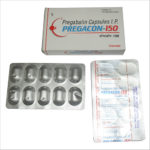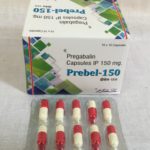Safety & Guarantee Shipping to United Kingdom, United States!
| Active substance | Pregabalin (C8H17NO2) |
| US Brand | Lyrica |
| IN Brand | Prebel, Pregacon |
| Manufacturing by | Johnlee Pharma, Concertina Pharma Pvt. Ltd |
| Strength | 75mg / 150mg |
| Form release | Blister 10 capsules |
| Shipping time | 7 – 18 days (Depending from the Country) |
| Availability & Order | through request form |
Pregabalin, marketed under the brand name Lyrica among others, is a medication used to treat epilepsy, neuropathic pain, fibromyalgia, and generalized anxiety disorder. Its use for epilepsy is as an add-on therapy for partial seizures with or without secondary generalization in adults. Some off-label uses of pregabalin include restless leg syndrome, prevention of migraines, social anxiety disorder, and alcohol withdrawal.
Seizure
Pregabalin is useful when added to other treatments, when those other treatments are not controlling partial epilepsy. Its use alone is less effective than some other seizure medications. It is unclear how it compares to gabapentin for this use.
Neuropathic pain
The European Federation of Neurological Societies recommends pregabalin as a first line agent for the treatment of pain associated with diabetic neuropathy, post-herpetic neuralgia, and central neuropathic pain. A minority obtain substantial benefit, and a larger number obtain moderate benefit. Other first line agents, including gabapentin and tricyclic antidepressants, are given equal weight as first line agents, and unlike pregabalin, are available as less expensive generics.
Pregabalin is not recommended for certain other types of neuropathic pain such as pain that of trigeminal neuralgia and its use in cancer-associated neuropathic pain is controversial. There is no evidence for its use in the prevention of migraines and gabapentin has been found not to be useful. It has been examined for the prevention of post-surgical chronic pain, but its utility for this purpose is controversial.
Pregabalin is generally not regarded as efficacious in the treatment of acute pain. Trials examining the utility of pregabalin for the treatment of acute post-surgical pain, no effect on overall pain levels was observed, but people did require less morphine and had fewer opioid-related side effects. Several possible mechanisms for pain improvement have been discussed.
Anxiety disorders
The World Federation of Biological Psychiatry recommends pregabalin as one of several first line agents for the treatment of generalized anxiety disorder, but recommends other agents such as SSRIs as first line treatment for obsessive-compulsive disorder and post-traumatic stress disorder. It appears to have anxiolytic effects similar to benzodiazepines with less risk of dependence.
The effects of pregabalin appear after 1 week of use and is similar in effectiveness to lorazepam, alprazolam, and venlafaxine, but pregabalin has demonstrated superiority by producing more consistent therapeutic effects for psychosomatic anxiety symptoms. Long-term trials have shown continued effectiveness without the development of tolerance, and, in addition, unlike benzodiazepines, it has a beneficial effect on sleep and sleep architecture, characterized by the enhancement of slow-wave sleep. It produces less severe cognitive and psychomotor impairment compared to those drugs; it also has a low potential for abuse and dependence and may be preferred over the benzodiazepines for these reasons.
Usual Adult Dose for Diabetic Neuropathy
-Initial dose: 50 mg orally 3 times a day
-Titration: The dose may be increased to 100 mg orally 3 times a day within 1 week based on efficacy and tolerability
-Maximum dose: 100 mg orally 3 times a day in patients with a creatinine clearance of at least 60 mL/min
Comment:
-This drug may be taken with or without food.
Use: Management of neuropathic pain associated with diabetic peripheral neuropathy
Usual Adult Dose for Postherpetic Neuralgia
-Initial dose: 75 mg orally 2 times a day OR 50 mg orally 3 times a day
-Titration: The dose may be increased to 100 mg orally 3 times a day within 1 week based on efficacy and tolerability
-Maintenance dose: 75 to 150 mg orally 2 times a day OR 50 to 100 mg orally 3 times a day (150 to 300 mg/day) in patients with a creatinine clearance of at least 60 mL/min
-Maximum dose: Patients who do not experience sufficient pain relief following 2 to 4 weeks of treatment with 300 mg/day and who are able to tolerate this drug, may be treated with up to 300 mg orally 2 times a day or 200 mg orally 3 times a day (due to the dose-dependent adverse effects and the higher rate of treatment discontinuation due to adverse events, dosing above 300 mg/day should be reserved only for those patients who have ongoing pain and are tolerating 300 mg daily)
Comment:
-This drug may be taken with or without food.
Use: Management of postherpetic neuralgia
Usual Adult Dose for Epilepsy
-Initial dose: 75 mg orally 2 times a day OR 50 mg orally 3 times a day
-Maintenance dose: 150 mg/day to 600 mg/day (the total daily dose should be divided and given either 2 or 3 times a day)
-Maximum dose: 600 mg/day in 2 or 3 divided doses based on individual patient response and tolerability
Comments:
-This drug may be taken with or without food.
-The efficacy of add-on therapy in patients taking gabapentin has not been evaluated in controlled trials; therefore, dosing recommendations for the use of this combination cannot be offered.
Use: Adjunctive therapy for adult patients with partial onset seizures
Usual Adult Dose for Fibromyalgia
-Initial dose: 75 mg orally 2 times a day (150 mg/day)
-Titration: The dose may be increased to 150 mg orally 2 times a day (300 mg/day) within 1 week based on efficacy and tolerability
-Maintenance dose: 300 to 450 mg/day in 2 divided doses
-Maximum dose: Patients who do not experience sufficient benefit with 300 mg/day may be further increased to 225 mg orally 2 times a day (450 mg/day)
Comments:
-This drug may be taken with or without food.
Use: Management of fibromyalgia
Although pregabalin was also studied at 600 mg/day, there is no evidence that this dose confers additional benefit and this dose was less well tolerated. In view of the dose-dependent adverse reactions, treatment with doses above 450 mg/day is not recommended.
Usual Adult Dose for Neuropathic Pain
-Initial dose: 75 mg orally 2 times a day
-Titration: The dose may be increased to 150 mg orally 2 times a day within 1 week based on efficacy and tolerability
-Maintenance dose: 150 to 600 mg/day in divided doses
-Maximum dose: Patients who do not experience sufficient pain relief after 2 to 3 weeks of treatment with 150 mg orally 2 times a day and who tolerate this drug may be treated with up to 300 mg orally 2 times a day
Comments:
-This drug may be taken with or without food.
Use: Neuropathic pain associated with spinal cord injury
Renal Dose Adjustments
-CrCl less than 15 mL/min:
Initial dose: 25 mg orally once daily
Maintenance dose: 25 to 75 mg orally once daily
-CrCl 15 to 30 mL/min:
Initial dose: 25 to 50 mg orally per day in 1 to 2 divided doses
Maintenance dose: 25 to 150 mg orally per day in 1 to 2 divided doses
-CrCl 30 to 60 mL/min:
Initial dose: 75 mg orally per day in 2 or 3 divided doses
Maintenance dose: 75 to 300 mg orally per day in 2 to 3 divided doses
For patients undergoing hemodialysis, adjust the daily dose based on renal function; in addition to the daily dose adjustment, administer a supplemental dose immediately following every 4-hour hemodialysis treatment:
-Patients on the 25 mg/day regimen: take one supplemental dose of 25 mg or 50 mg
-Patients on the 25 to 50 mg/day regimen: take one supplemental dose of 50 mg or 75 mg
Patients on the 50 to 75 mg/day regimen: take one supplemental dose of 75 mg or 100 mg
Patients on the 75 mg/day regimen: take one supplemental dose of 100 mg or 150 mg
Pregabalin has been shown to produce therapeutic effects that are similar to other controlled substances. In a study with recreational users of sedative and hypnotic drugs, a 450 mg dose of pregabalin resulted in subjective ratings of a “good drug effect” and “high” and “liking” similar to 30 mg of diazepam. In clinical studies, pregabalin showed a side effect profile similar to other central nervous system depressants.

